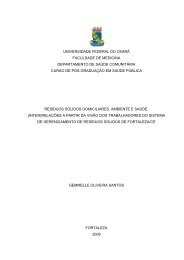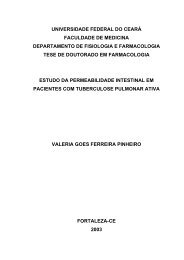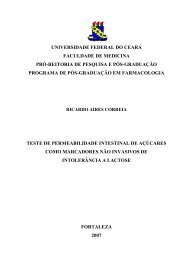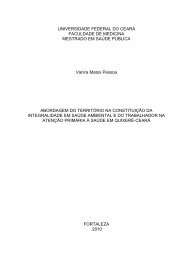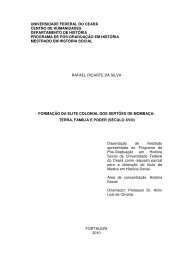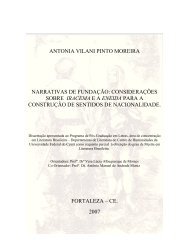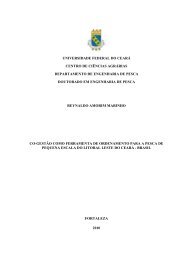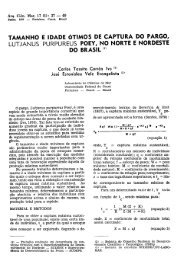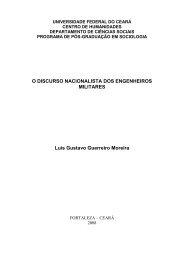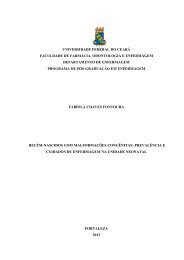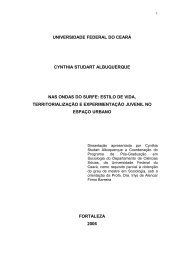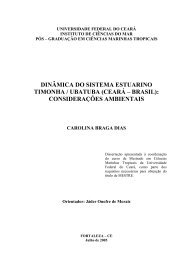Tungíase: doença negligenciada causando patologia grave
Tungíase: doença negligenciada causando patologia grave
Tungíase: doença negligenciada causando patologia grave
You also want an ePaper? Increase the reach of your titles
YUMPU automatically turns print PDFs into web optimized ePapers that Google loves.
Risk Factors for Tungiasis in Nigeria: Identification of<br />
Targets for Effective Intervention<br />
Uade Samuel Ugbomoiko 1 , Liana Ariza 2 , Ifeanyi Emmanuel Ofoezie 3 , Jörg Heukelbach 2,4 *<br />
1 Department of Zoology, University of Ilorin, Ilorin, Nigeria, 2 Department of Community Health, School of Medicine, Federal University of Ceará, Fortaleza, Brazil,<br />
3 Department of Zoology, University of Nigeria, Nsukka, Nigeria, 4 School of Public Health, Tropical Medicine and Rehabilitation Sciences, James Cook University,<br />
Townsville, Australia<br />
Abstract<br />
Background: The parasitic skin disease tungiasis (caused by the flea Tunga penetrans) affects resource-poor communities in<br />
Latin America, the Caribbean and sub-Saharan Africa. Prevalences in endemic areas are high, and severe pathology occurs<br />
commonly. However, risk factors for infestation have never been assessed in Africa.<br />
Methods and Findings: A cross-sectional study was conducted in Erekiti, a rural community in Lagos State (Nigeria), where<br />
tungiasis is endemic. Individuals were examined clinically for the presence of tungiasis, and a questionnaire was applied.<br />
Data from 643 individuals (86.6% of the target population) were analyzed; 252 (42.5%) were infested with T. penetrans. In<br />
the multivariate logistic regression analysis, presence of pigs on the compounds (adjusted odds ratio = 17.98; 95%<br />
confidence interval: 5.55–58.23), sand or clay floor inside houses (9.33; 5.06–17.19), and having the common resting place<br />
outside the house (7.14; 4.0–14.29) were the most important risk factors identified. The regular use of closed footwear (0.34;<br />
0.18–0.62) and the use of insecticides indoors (0.2; 0.05–0.83) were protective against infestation. The population<br />
attributable fractions associated with tungiasis were: sand or clay floor inside the house (73.7%), resting usually outside the<br />
house (65.5%), no regular use of closed footwear (51.1%), and pigs on the compound (37.9%).<br />
Conclusion: The presence of tungiasis in Erekiti is determined to an important extent by a limited number of modifiable<br />
variables. Effective and sustainable intervention measures addressing these factors need to be implemented in this and<br />
other West African communities with high disease burden.<br />
Citation: Ugbomoiko US, Ariza L, Ofoezie IE, Heukelbach J (2007) Risk Factors for Tungiasis in Nigeria: Identification of Targets for Effective Intervention. PLoS<br />
Negl Trop Dis 1(3): e87. doi:10.1371/journal.pntd.0000087<br />
Editor: Helton Santiago, George Washington School of Medicine, United States of America<br />
Received: April 2, 2007; Accepted: August 13, 2007; Published: December 5, 2007<br />
Copyright: ß 2007 Ugbomoiko et al. This is an open-access article distributed under the terms of the Creative Commons Attribution License, which permits<br />
unrestricted use, distribution, and reproduction in any medium, provided the original author and source are credited.<br />
Funding: The authors received no specific funding for this study.<br />
Competing Interests: The authors have declared that no competing interests exist.<br />
*E-mail: heukelbach@web.de<br />
Introduction<br />
The parasitic skin disease tungiasis is caused by the permanent<br />
penetration of the female sand flea Tunga penetrans into the<br />
epidermis of its host. After penetration, the female undergoes<br />
a hypertrophy and reaches the size of a pea. Tungiasis has many<br />
features of a neglected tropical disease and thus can be considered<br />
as a paradigm: it is endemic in poor communities and rural areas,<br />
it is associated with stigma, and there is no commercial market for<br />
products targeting the disease [1–3]. The disease only sporadically<br />
affects travelers to endemic areas in South America and Africa,<br />
whereas people living in local communities commonly suffer from<br />
severe infestation and associated pathology [4,5]. Associated<br />
pathology includes bacterial superinfection, pain, fissures hindering<br />
individuals from walking normally, as well as deformation and<br />
loss of toenails and digits [1,6–8]. Tungiasis lesions have also been<br />
described to be port of entry for tetanus infection [7,9,10].<br />
The sand flea originally occurred only on the American<br />
continent and the Caribbean Islands, but spread in the late 19 th<br />
century throughout sub-Saharan Africa and to Madagascar [1,11].<br />
Two recent studies from Nigeria and Cameroon indicate that still<br />
today tungiasis is a major public health problem in West Africa<br />
[12,13].<br />
In the past few years, the public health importance of tungiasis<br />
in resource-poor populations has been highlighted from different<br />
countries, including Brazil, Argentina, Haiti and Nigeria<br />
[7,14,15]. However, risk factors for infestation have only been<br />
addressed in a single study from Brazil [16], and sustainable<br />
intervention measures have never been assessed systematically.<br />
Control programs aiming at the reduction of severe morbidity are<br />
nonexistent.<br />
Here we present the results of a cross-sectional study identifying<br />
major risk factors for tungiasis in a rural community in Nigeria.<br />
The results show that several modifiable factors, which can be<br />
addressed in control programs, are important determinants for<br />
infestation.<br />
Methods<br />
Study area<br />
The study was conducted in Erekiti, a community located about<br />
50 km west from Lagos, the capital of Lagos State, Nigeria.<br />
The community can be regarded as typical for a small rural<br />
village in Western Nigeria; the characteristics have been described<br />
in detail elsewhere [13]. In brief, Erekiti has a population of about<br />
1200 inhabitants. The community lacks appropriate urban<br />
PLoS Neglected Tropical Diseases | www.plosntds.org 1 2007 | Volume 1 | Issue 3 | e87



